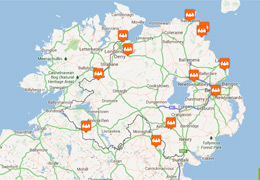If you find a bat on the ground, or in an exposed area, especially during the day, is likely to need help.
How can I help?
Please follow the instructions below! We would appreciate it if you can submit your record (even if the bat flies away successfully) through our online form.
If the bat is on the ground, on an outside wall, or in an exposed area where it may be vulnerable, you should should first try to contain it in a box (see the instructions below) before attempting to release or rescue it.
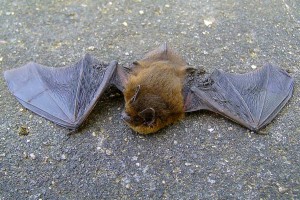
Grounded common pipistrelle
Please don’t assume the bat is healthy and leave it outside to fly away.
A grounded bat is likely to need urgent care!
Contain the bat
You should avoid handling the bat, but if it is necessary WEAR GLOVES AND USE A TEA TOWEL TO LIFT THE BAT
You will need:
- A shoe box, with holes punched in the lid (or container of equivalent size)
- A cloth or teatowel
- A plastic bottle cap (milk bottle tops are perfect)
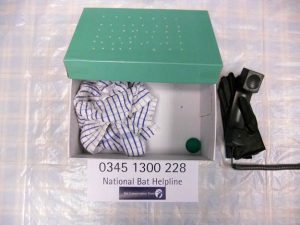
An ideal bat hotel
1. Move the bat into the shoe box or box either:-
a) Like a spider, by placing a box on top of it and sliding a piece of card underneath…
Or:-
b) Alternatively, cover the bat with a cloth/teatowel and carefully scoop it up and place it in the box. (You should not handle the bat with bare hands.)
2. Put a tea towel or soft cloth in the box for the bat to hide in.
3. Put in a small, shallow container e.g. a plastic milk bottle top with a few drops of water (not enough for the bat to drown in). Make sure the water is topped up regularly.
4. Keep the bat indoors somewhere quiet and dark, not anywhere too warm or too cold (a garage or shed is usually perfect).
Well done, the bat is now contained!
If you have a baby bat
During the summer months, it is also possible to sometimes find a baby bat (pup) that has either been orphaned or lost its way from a roost. If you find a young or baby bat this should be treated as urgent as it will be extremely vulnerable and cannot survive on its own. A baby bat will be about the size of a pound coin and have little or no fur, but pups grow fast and can be nearly the size of an adult (see below). They tend to be skinnier and cannot fly.
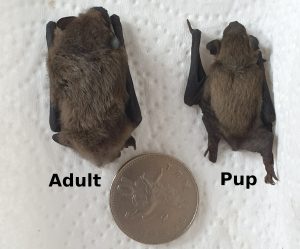
Mother and baby soprano pipistrelle
If you have a young bat:- please report it ASAP by filling out our query form HERE. A member of CeDAR/NIEA or one of our volunteers should contact you to collect the bat or give you further advice.
If you have an adult bat
Is the bat visibly injured or is it a known cat attack?
Can you see any signs of injury e.g. blood, wing tears, bone fractures etc or do you suspect a cat may have attacked the bat? In this case you need to get the bat to a vet ASAP, cats saliva is toxic to bats and they are likely to die as a result unless the can get antibiotics quickly. Please fill out our query form HERE and take it to a vet immediately or as soon as you can.
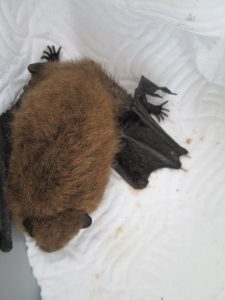
Wing break from cat attack
Is the bat moving slowly or not at all?
Even if there are no signs of injury or you dont think a cat attacked the bat, the bat may be sluggish and weak. Most grounded bats end up in this state as they are dehydrated, hungry or sick. A healthy bat should be very energetic and trying to escape! If the bat is sluggish do not attempt to release it as it will either not fly or attempt to fly and crash land. In this case please fill out our online form HERE and a member of CEDaR/NIEA or one of our volunteers should contact you to collect the bat or give you further advice.
The bat looks healthy with no signs of injury
Time to try to release him 🙂
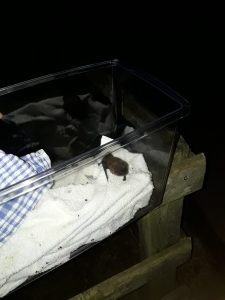
Bat warming up for release!
If you find a bat during the winter months (November-February) or during periods of bad weather (colder than 7C, or windy, or wet) please do not attempt release the bat, instead contact us through the form here.
The timing to release bats is also critical, do not release them during the day, as they are extremely vulnerable to daytime predators. For most bats shortly after sunset is an ideal time to try to release them.
Check this link to find out the sunset time and try to release the bat between 30 and 45 minutes after sunset.
Ideally place the container or box with the bat up on a high ledge or platform so the bat has room to take off, around head height should be fine. Then just lift the lid to allow the bat to escape. They may take some time to warm themselves up to get ready to fly, 10 minutes is typical, but if the bat has not tried to fly after 60 minutes it is unlikely they will do so. In this case please bring the bat back inside and contact us through our online form HERE and a member of CEDaR/NIEA or one of our volunteers should contact you to collect the bat or give you further advice.
The bat flies successfully
If the bat flies away without incident then your job is done! Well done. We would still like to hear from you, so we would appreciate it if you could fill out our form so as we have a record of the bat.
The bat does not fly away successfully
Please try to re-contain the bat as per the instructions as above and contact us through our online form HERE and a member of CEDaR/NIEA or one of our volunteers should contact you to collect the bat or give you further advice.
